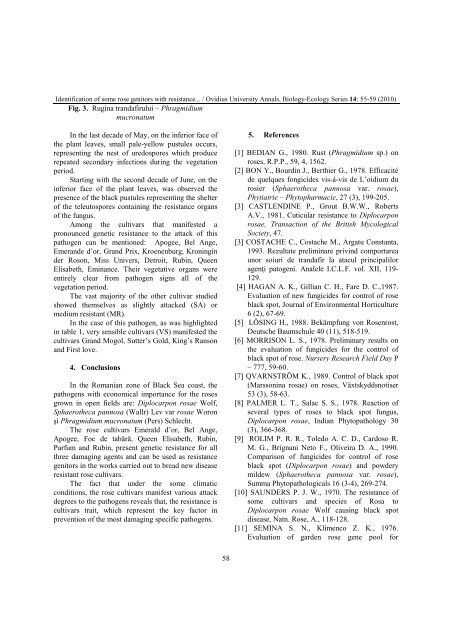VOLUM OMAGIAL - Facultatea de Ştiinţe ale Naturii şi Ştiinţe Agricole
VOLUM OMAGIAL - Facultatea de Ştiinţe ale Naturii şi Ştiinţe Agricole
VOLUM OMAGIAL - Facultatea de Ştiinţe ale Naturii şi Ştiinţe Agricole
You also want an ePaper? Increase the reach of your titles
YUMPU automatically turns print PDFs into web optimized ePapers that Google loves.
I<strong>de</strong>ntification of some rose genitors with resistance... / Ovidius University Annals, Biology-Ecology Series 14: 55-59 (2010)<br />
Fig. 3. Rugina trandafirului – Phragmidium<br />
mucronatum<br />
In the last <strong>de</strong>ca<strong>de</strong> of May, on the inferior face of<br />
the plant leaves, small p<strong>ale</strong>-yellow pustules occurs,<br />
representing the nest of uredospores which produce<br />
repeated secondary infections during the vegetation<br />
period.<br />
Starting with the second <strong>de</strong>ca<strong>de</strong> of June, on the<br />
inferior face of the plant leaves, was observed the<br />
presence of the black pustules representing the shelter<br />
of the teleutospores containing the resistance organs<br />
of the fungus.<br />
Among the cultivars that manifested a<br />
pronounced genetic resistance to the attack of this<br />
pathogen can be mentioned: Apogee, Bel Ange,<br />
Emeran<strong>de</strong> d’or, Grand Prix, Kroenenburg, Kroningin<br />
<strong>de</strong>r Roson, Miss Univers, Detroit, Rubin, Queen<br />
Elisabeth, Eminance. Their vegetative organs were<br />
entirely clear from pathogen signs all of the<br />
vegetation period.<br />
The vast majority of the other cultivar studied<br />
showed themselves as slightly attacked (SA) or<br />
medium resistant (MR).<br />
In the case of this pathogen, as was highlighted<br />
in table 1, very sensible cultivars (VS) manifested the<br />
cultivars Grand Mogol, Sutter’s Gold, King’s Ranson<br />
and First love.<br />
4. Conclusions<br />
In the Romanian zone of Black Sea coast, the<br />
pathogens with economical importance for the roses<br />
grown in open fields are: Diplocarpon rosae Wolf,<br />
Sphaerotheca pannosa (Wallr) Lev var rosae Woron<br />
<strong>şi</strong> Phragmidium mucronatum (Pers) Schlecht.<br />
The rose cultivars Emerald d’or, Bel Ange,<br />
Apogee, Foc <strong>de</strong> tabără, Queen Elisabeth, Rubin,<br />
Parfum and Rubin, present genetic resistance for all<br />
three damaging agents and can be used as resistance<br />
genitors in the works carried out to bread new disease<br />
resistant rose cultivars.<br />
The fact that un<strong>de</strong>r the some climatic<br />
conditions, the rose cultivars manifest various attack<br />
<strong>de</strong>grees to the pathogens reveals that, the resistance is<br />
cultivars trait, which represent the key factor in<br />
prevention of the most damaging specific pathogens.<br />
58<br />
5. References<br />
[1] BEDIAN G., 1980. Rust (Phragmidium sp.) on<br />
roses, R.P.P., 59, 4, 1562.<br />
[2] BON Y., Bourdin J., Berthier G., 1978. Efficacité<br />
<strong>de</strong> quelques fongici<strong>de</strong>s vis-á-vis <strong>de</strong> L’oidium du<br />
rosier (Sphaerotheca pannosa var. rosae),<br />
Phytiatrie – Phytopharmacie, 27 (3), 199-205.<br />
[3] CASTLENDINE P., Grout B.W.W., Roberts<br />
A.V., 1981. Cuticular resistance to Diplocarpon<br />
rosae, Transaction of the British Mycological<br />
Society, 47.<br />
[3] COSTACHE C., Costache M., Argatu Constanta,<br />
1993. Rezultate preliminare privind comportarea<br />
unor soiuri <strong>de</strong> trandafir la atacul principalilor<br />
agenţi patogeni. An<strong>ale</strong>le I.C.L.F. vol. XII, 119-<br />
129.<br />
[4] HAGAN A. K., Gillian C. H., Fare D. C.,1987.<br />
Evaluation of new fungici<strong>de</strong>s for control of rose<br />
black spot, Journal of Environmental Horticulture<br />
6 (2), 67-69.<br />
[5] LÖSING H., 1988. Bekämpfung von Rosenrost,<br />
Deutsche Baumschule 40 (11), 518-519.<br />
[6] MORRISON L. S., 1978. Preliminary results on<br />
the evaluation of fungici<strong>de</strong>s for the control of<br />
black spot of rose. Nursery Research Field Day P<br />
– 777, 59-60.<br />
[7] QVARNSTRÖM K., 1989. Control of black spot<br />
(Marssonina rosae) on roses, Växtskyddsnotiser<br />
53 (3), 58-63.<br />
[8] PALMER L. T., Salac S. S., 1978. Reaction of<br />
several types of roses to black spot fungus,<br />
Diplocarpon rosae, Indian Phytopathology 30<br />
(3), 366-368.<br />
[9] ROLIM P. R. R., Toledo A. C. D., Cardoso R.<br />
M. G., Brignani Neto F., Oliveira D. A., 1990.<br />
Comparison of fungici<strong>de</strong>s for control of rose<br />
black spot (Diplocarpon rosae) and pow<strong>de</strong>ry<br />
mil<strong>de</strong>w (Sphaerotheca pannosa var. rosae),<br />
Summa Phytopathologicals 16 (3-4), 269-274.<br />
[10] SAUNDERS P. J. W., 1970. The resistance of<br />
some cultivars and species of Rosa to<br />
Diplocarpon rosae Wolf causing black spot<br />
disease, Natn. Rose, A., 118-128.<br />
[11] SEMINA S. N., Klimenco Z. K., 1976.<br />
Evaluation of gar<strong>de</strong>n rose gene pool for





